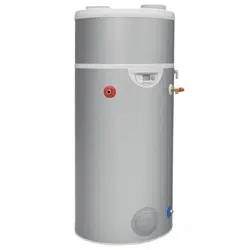Loading ...
Loading ...
Loading ...

8
Installation
5.8.3 Termination of discharge pipe
- “The discharge pipe (D2) from the tundish should
terminate in a safe place where there is no risk to
persons in the vicinity of the discharge.”
Examples of acceptable discharge arrangements are:
- “To a trapped gully with the end of the pipe below a
- Downward discharges at low level; i.e. up to 100mm
above external surfaces such as car parks, hard
standings, grassed areas etc. are acceptable providing
that a wire cage or similar guard is positioned to
prevent contact, whilst maintaining visibility; and ,
- Discharges at high level: e.g. into a metal hopper and
metal downpipe with the end of the discharge pipe
clearly visible or onto a roof capable of withstanding
high temperature discharges of water and 3m from
any plastic guttering system that would collect such
discharges.”
6 Installation
6.1 Correctly Siting the Water Heater
Install the water heater in an appropriate location,
ensuring all of the recommendations have been
considered (see Section 5.6).
6.2.1 Install the Inlet Group
The inlet group regulates the pressure of the incoming
mains water supply to the water heater and removes
any debris that might be water borne.
Between the inlet group and the cold
water inlet on the water heater NO isolating
safety devices could be isolated!
6.2.2 Expansion Vessel
The expansion vessel is mandatory on the Dimplex
water heater and can be connected directly to the cold
with the vessel. The expansion vessel should always be
instructions, see Figure 3. No isolating device should be
group.
Furthermore, it is recommended to mount the vessel
higher than the water heater to avoid having to drain
the water heater when maintaining and replacing the
expansion vessel.
It is important to check the pre-charge pressure of the
The pre-charge should be greater than or equal to 3
bar.
6.2 Cold Water Inlet with Inlet Group
- The discharge pipe should not be connected to a soil
discharge stack unless the soil discharge stack is
capable of safely withstanding temperatures of the
water discharged, in which case, it should:
-Contain a mechanical seal, which allows water into the
branch pipe without allowing foul air from the drain to
be ventilated through the tundish.
- There should be a separate branch pipe with no
sanitary appliances connected to it.
- If plastic pipes are used as branch pipes carrying
discharge from a safety device, they should be either
polybutalene (PB) or cross-linked polyethylene (PE-X)
complying with national standards.
- Be continuously marked with a warning that no
sanitary appliances should be connected to the
pipe.
5.9 Product Disposal
This product has been manufactured from
mostly recyclable materials. At the end of the
product’s life, it should be disposed of at a Local
Authority Recycling Centre.
Materials:
• Inner Cylinder - Stainless Steel
• Outer Cladding - HIPS/ABS (Polypropylene BE 50)
• Inlet/Outlet Pipe - Plastic (Polypropylene BE 50)
• Insulation - 50mm PU Foam (GWP =1, ODP =0)
Connections & Fasteners:
• Inlet/Oulet - stainless steel
• T&P Valve - ½”F BSP
• Immersion Heater - 1 ¼”F BSP
!
!
Safety & Control:
• Cold water inlet group - brass
• Tundish - acetal co-polymer
• T&P Valve - brass
- Where a single common discharge pipe serves more
than one system, it should be at least one pipe size
larger than the largest individual discharge pipe (D2)
to be connected.
As the discharge would consist of high
felt and non-metallic rainwater goods may be
damaged by such discharges.
Therefore the maximum permitted length equates to
5.8m, which is less than the actual length of 7m,
therefore calculate the next largest size.
Maximum resistance allowed for a straight length of
28mm copper discharge pipe (D2) from a G½
temperature relief valve is: 18m.
Subtract the resistance for 4 No. 28mm elbows at 1.0m
each = 4m.
Therefore the maximum permitted length equates to
14m.
As the actual length is 7m, a 28mm (D2) copper pipe will
be satisfactory.
Loading ...
Loading ...
Loading ...
